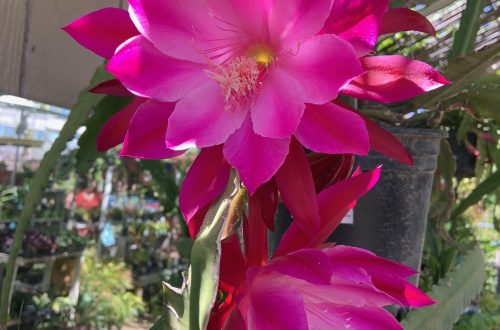Are you a plant enthusiast looking to add a touch of exotic beauty to your garden? Enter the world of Epiphyllums, affectionately known as Orchid Cactus, or “Epi” for short. These stunning plants, though lesser-known, offer a wealth of charm and elegance to any plant collection. Join me as we dive into the wonders of Epiphyllums, from their natural habitat, to caring for them in your Sacramento garden, to where you can see and purchase your own.
A Little History
I’ll never forget when, where and who first introduced me to these intriguing plants. A dear customer, Claudia, arrived at the nursery one day a decade ago with a potted plant that looked a little like “green beef jerky” to quote my daughter Jasmine! I’m sure she sensed my skepticism, but she told me I’d understand why we needed these in our nursery once I saw them bloom. She couldn’t have been more correct! Epi’s tend to be hard to find in local garden stores, but I did manage to add two more to my collection and I was hooked. Then, several years later another wonderful customer, Carolyn, saw my fledgling collection and we did what plant lovers often do … we proceeded to geek out and talk Epi for an hour or so. Carolyn then graciously offered to share some of her private stock with me and be my Epi Guru. I can not thank Claudia and Carolyn enough for their gifts of plant material, time and expertise.

Where They Grow Naturally
Epiphyllums originate from the tropical regions of Central and South America, where they thrive in the dappled shade of forest canopies. As epiphytic plants, they cling to trees or rocks, drawing moisture and nutrients from the air and organic matter around them. Their natural habitat provides valuable insights into their preferred growing conditions.
Ideal Growing Conditions in Sacramento (Zone 9b)
In Sacramento’s climate (Zone 9b), Epiphyllums flourish with a little extra care. These plants prefer well-draining soil, enriched with organic matter, and partial shade to mimic their natural environment. Protect them from harsh afternoon sun and provide adequate humidity, especially during hot summer months. With proper attention to watering and temperature, your Epiphyllums can thrive in Sacramento’s climate.

Caring for Epiphyllums
Caring for Epiphyllums is relatively straightforward, making them a delightful addition to any garden. Here are some essential care tips:
- Watering: Keep the soil consistently moist but not waterlogged, especially during the growing season. Reduce watering in the winter months to prevent root rot.
- Fertilizing: Feed your Epiphyllum regularly during the growing season with a balanced fertilizer to support healthy growth. For best bloom set, fertilize in early March with a higher Phosphorus ratio. We recommend Dr. Earth Organic Flower Girl.
- Pruning: Trim back any leggy or damaged growth to promote bushier, more compact plants. Remove spent blooms to encourage continued flowering, or allow some blooms to set fruit. (The fruit tastes like dragon fruit.)
- Repotting: Repot your Epiphyllums every 2-3 years to refresh the soil. Epis like to be somewhat root constricted though and will put on the best flower show if kept in tight quarters.
Blooming Season
While potted epi’s are charming in a hanging planter year-round, certainly their most enchanting trait is their spectacular blooms. While specific blooming times may vary depending on the variety and growing conditions, they typically flower in late spring. Prepare to be mesmerized by a profusion of vibrant colors, including pinks, yellows, magentas and corals, as your Epiphyllum burst into bloom. The size of each bloom also depends on the variety, but 6-8″ in diameter is pretty normal. Breathtaking!!!!

Starting Your Own Collection
Exciting news! We’re thrilled to announce that The Secret Garden opens its private collection of Epiphyllums for viewing every Spring as we approach bloom time. While our collection is not for sale, we offer potted Epiphyllums and Epiphyllum cuttings for sale during our Annual Spring Garden Faire & Plant Sale every year. Mark your calendars for April 27-28, 2024 and prepare to be inspired by the allure of Orchid Cacti. You do not want to miss this exclusive opportunity to explore the beauty and diversity of these remarkable plants. For more information about the event, follow this link.
See you in the garden!





